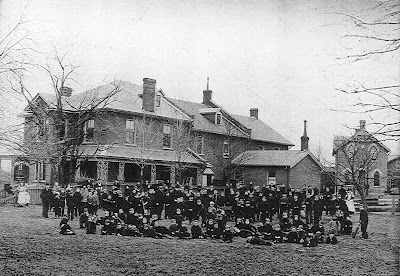All at sea
After the news at the weekend of the fate of a cruise ship off the coast of Italy, ironically on the eve of the Titanic anniversary, my thoughts turned to the thousands of our children who used this form of transport to cross the seas. The events of Friday are perhaps surprising in this modern age of computerized navigation systems, but travelling by ship has always had the possibility of a rough crossing or worse!
Between 1872 and 1914, 2129 children sailed across the seas to seek a new home abroad. The charity emigrated to a home called Marchmont in Belleville, Ontario, Canada. From here the children would go to farmers in the local area to help work the land or do domestic duties in the farmhouse. But to get there the party had to travel around 5,300km, across the Atlantic Ocean on one of the many ships that made the journey from Liverpool to Canada. It took around nine days to make the journey which was not always the gentlest of crossings.
Letter to the Refuge from William, aged 16:
To many the cramped conditions, poor diet and lurching of the crossing meant one trip was more than enough! But for the staff of the Refuge, who looked after the groups of children who travelled to Canada, the conditions were endured regularly, often twice a year. Miss Harriet Smethurst was one such member of staff. She joined the charity as Matron of Rosen Hallas, the girls’ emigration training home on George Street, Cheetham Hill in 1886 and worked for the organisation until 1923. During her long career she crossed the Atlantic no fewer than twenty times (there and back!) in charge of parties of our young emigrants. She must have had a strong stomach!
 |
| Marchmont receiving home, 193 Moria Street, Yeoman Hill, Canada |
Between 1872 and 1914, 2129 children sailed across the seas to seek a new home abroad. The charity emigrated to a home called Marchmont in Belleville, Ontario, Canada. From here the children would go to farmers in the local area to help work the land or do domestic duties in the farmhouse. But to get there the party had to travel around 5,300km, across the Atlantic Ocean on one of the many ships that made the journey from Liverpool to Canada. It took around nine days to make the journey which was not always the gentlest of crossings.
Letter to the Refuge from William, aged 16:
“I came out to Canada in the year 1900 April 5. Well we were on the ocean eight days before we reached Halifax. I can remember it quite well. I was quite sick but when we got on dry land I soon got well.”
 |
| Emigration report sent back to Manchester (taken from the Together Trust archive) |
To many the cramped conditions, poor diet and lurching of the crossing meant one trip was more than enough! But for the staff of the Refuge, who looked after the groups of children who travelled to Canada, the conditions were endured regularly, often twice a year. Miss Harriet Smethurst was one such member of staff. She joined the charity as Matron of Rosen Hallas, the girls’ emigration training home on George Street, Cheetham Hill in 1886 and worked for the organisation until 1923. During her long career she crossed the Atlantic no fewer than twenty times (there and back!) in charge of parties of our young emigrants. She must have had a strong stomach!

Thank you for taking the time to create this blog. I only "discovered" it a few weeks ago, so finding the posts of interest, especially relating to the "Home Children" sent to Canada.The photos are wonderful. Hope you will continue to post.
ReplyDeleteHi Julia,
ReplyDeleteThank you for the comment. We're glad you're enjoying the blog so far. We will be looking at a case study of a child who emigrated to Canada in the near future so keep checking back to find out more.